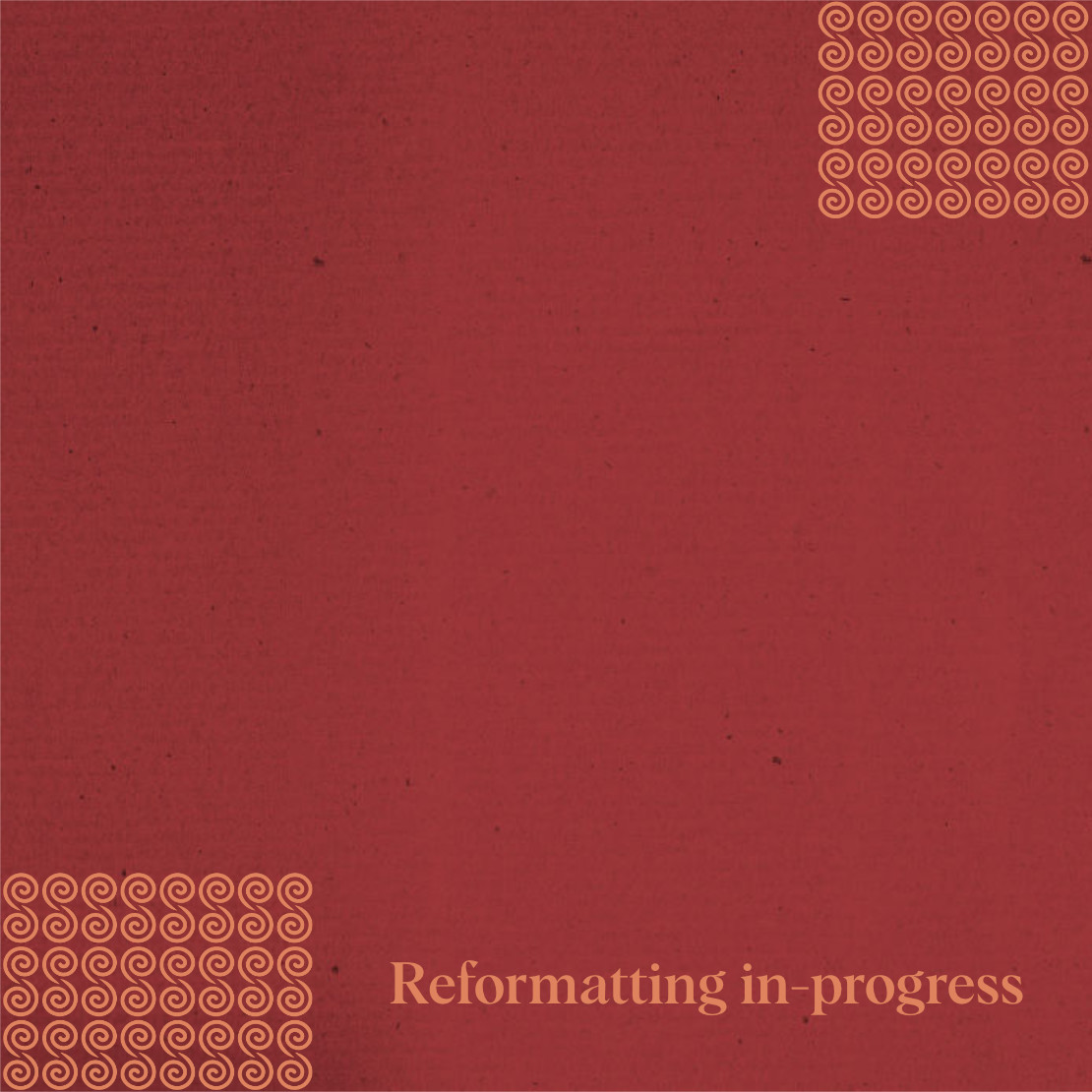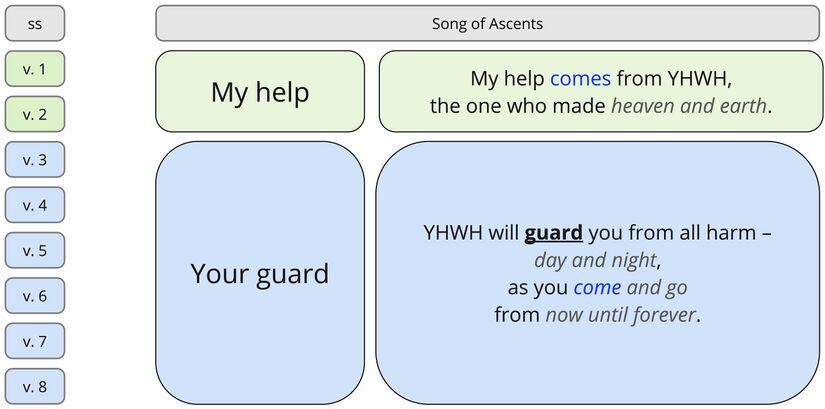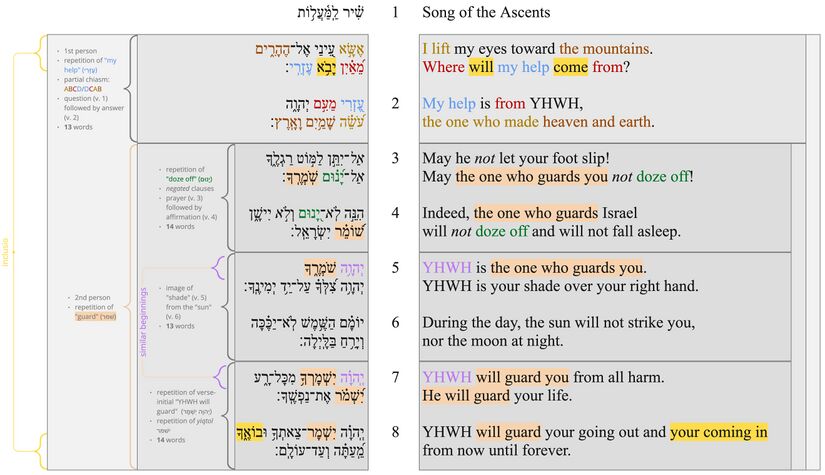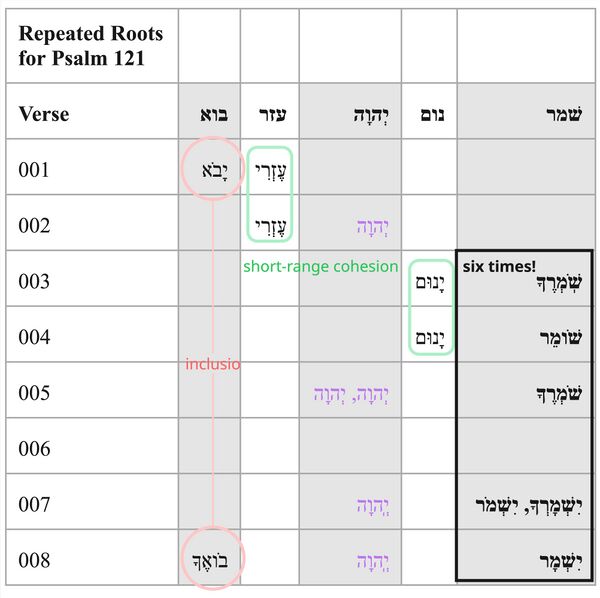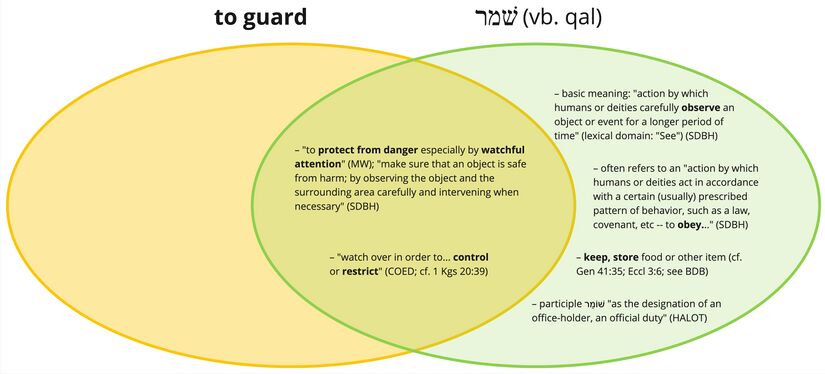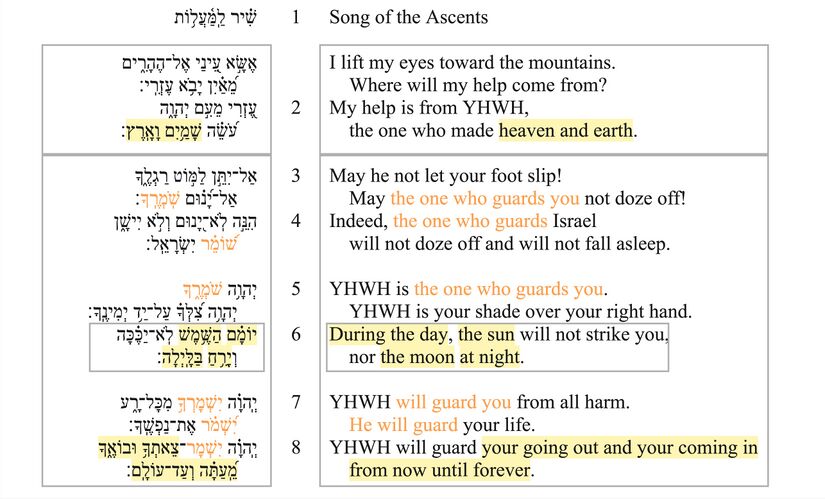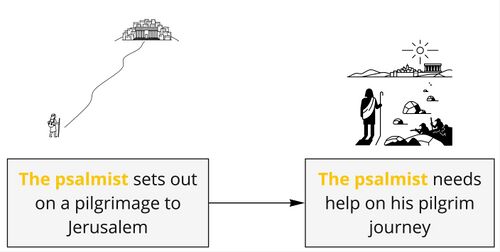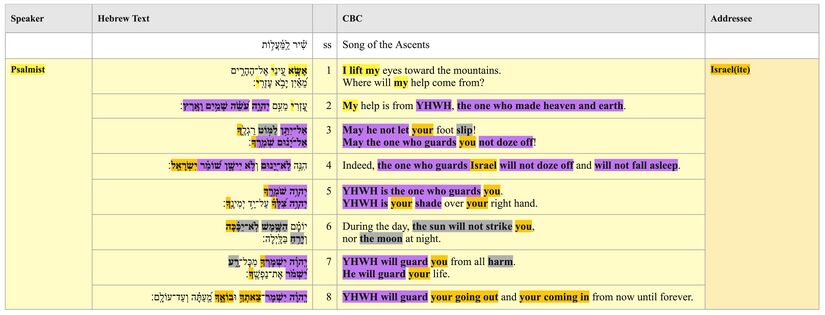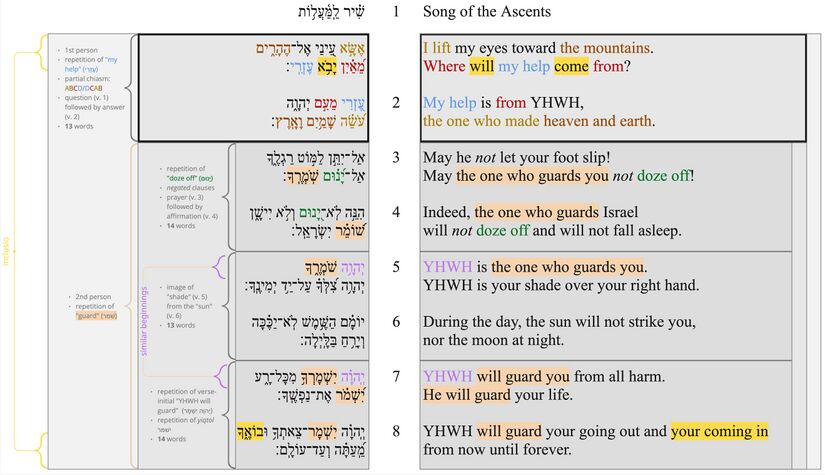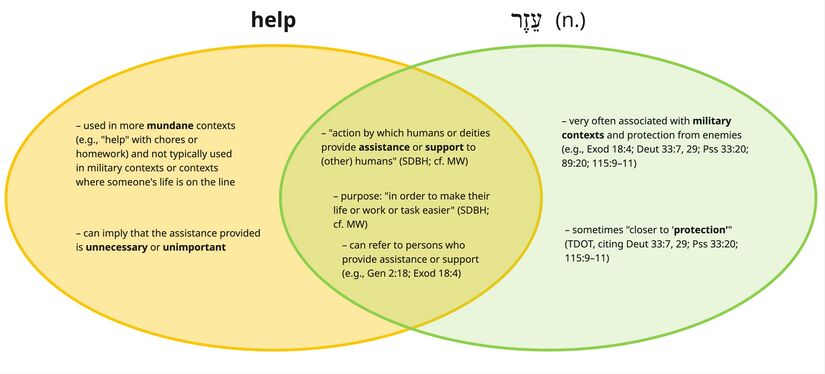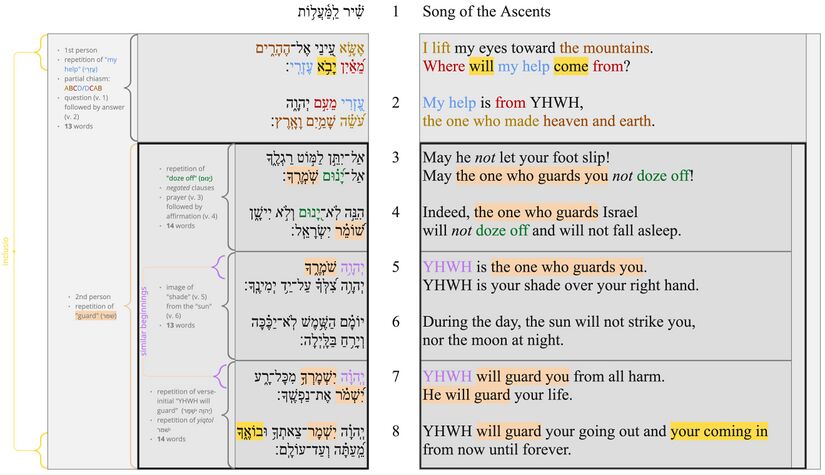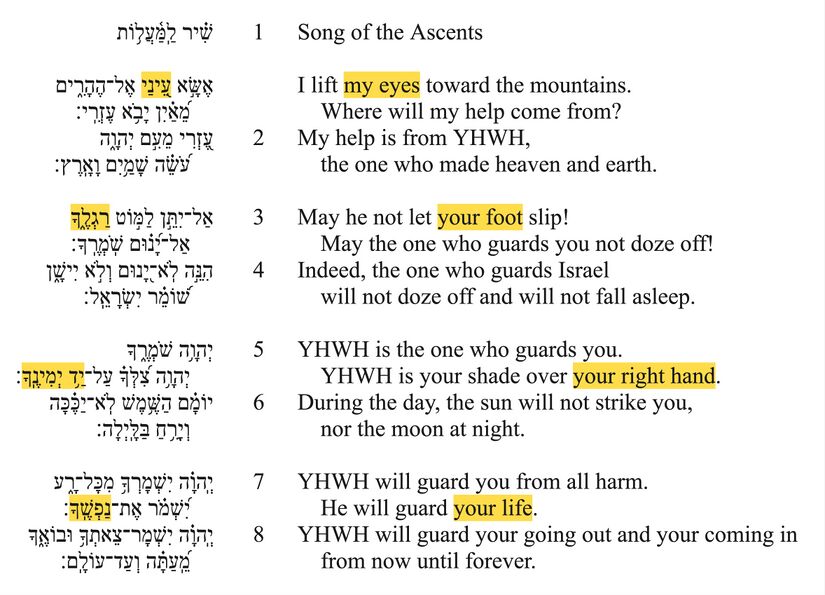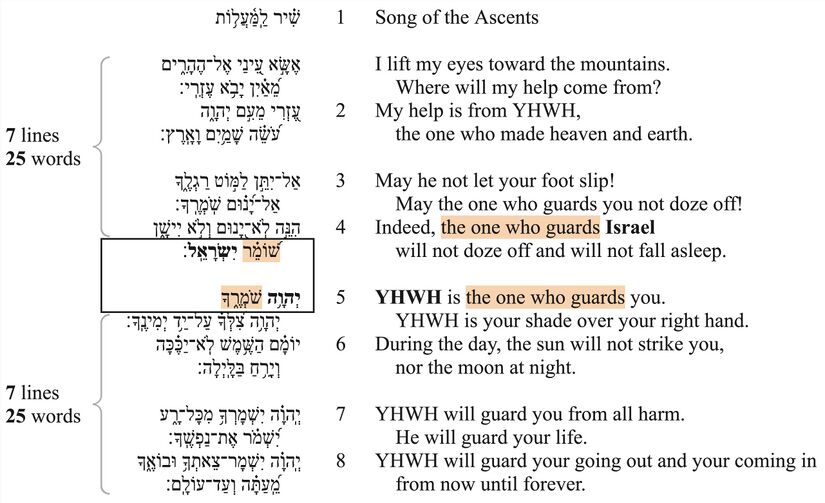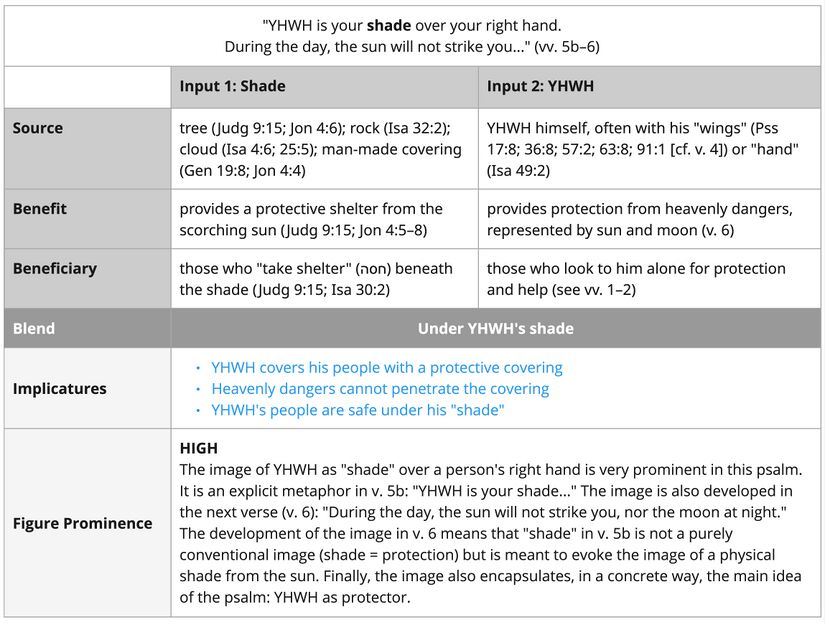Psalm 121 Verse by Verse
Verse-by-Verse Notes (Academic)
Welcome to the Verse-by-Verse Notes for Psalm 121!
The Verse-by-Verse Notes present scholarly, exegetical materials (from all layers of analysis) in a verse-by-verse format. They often present alternative interpretive options and justification for a preferred interpretation. The Verse-by-Verse Notes are aimed at consultant-level users.
The discussion of each verse of this psalm includes the following items.
- A link to the part of the overview video where the verse in question is discussed.
- The verse in Hebrew and English.[1]
- An expanded paraphrase of the verse.[2]
- A grammatical diagram of the verse, which includes glosses for each word and phrase.[3]
- A series of notes on the verse, which contain information pertaining to the interpretation of the psalm (e.g., meaning of words and phrases, poetic features, difficult grammatical constructions, etc.).
Introduction
Poetic Structure
Psalm 121 has a two-part structure: vv. 1–2, vv. 3–8.[4] The first part is distinguished by first-person language ("my eyes... my help") and the second part is distinguished by second-person language ("YHWH is the one who guards you," etc.). The keyword in the first part is "help" (repeated twice), and the keyword in the second part is "guard" (repeated six times). The following visual presents this basic two-part structure and summarizes the content of each part.
The following visual presents the poetic structure of the psalm in greater detail:
The poem shows clear signs of unity.
- It is bound by an inclusio ("come" [בוא], vv. 1, 8).
- It is united by the common theme of YHWH's protection, exemplified by the key word "guard" (שׁמר), which appears six (!) times (vv. 3–8). Although the word "guard" does not appear in vv. 1–2, "guarding" is closely related to the idea of "help," since both words involve protection from danger. Moreover, "guarding" is also related to the image of "lifting one's eyes," since the basic meaning of שׁמר ("guard") is to "watch."
- There are 54 words in the poem, corresponding to the numerical value of the keyword "guard" (שׁמר).[5] Shin is the 21st letter of the alphabet; mem the 13th, and resh the 20th. 21 + 13 + 20 = 54.
Because the second main part (vv. 3–8) subdivides into three parts, the psalm consists of four sub-sections (vv. 1–2, vv. 3–4, vv. 5–6, vv. 7–8).[6] Each sub-section is about the same length (4 lines and 13 words / 4 lines and 14 words / 4 lines and 13 words / 4 lines and 14 words).
Further details about the poetic structure will be discussed below.
Keyword: "Guard"
The word "guard" (שׁמר) occurs six times in this short eight-verse psalm (vv. 3, 4, 5, 7, 8). Furthermore, as discussed above, the psalm has 54 words, corresponding to the numerical value of the word "guard" (שׁמר). Thus, the word שׁמר is, by far, the most prominent word in this poem. Not only is it repeated six times within such a short span of text, but the numerical value of this word has determined the exact length of the poem. It is clear that the poet wants his readers to remember this idea above all: YHWH guards his people.
The following visual shows how words are repeated throughout the psalm. The most striking part of the visual is the dense repetition of "guard" (שׁמר).
Given the prominence of the word "guard" (שׁמר), it is important to clarify the meaning of this word. Modern English translations render שׁמר in this psalm with a variety of words: "keep" (NIV, ESV, NLT, NRSVUE), "watch over" (NIV), "preserve" (KJV), "protect" (NASB, CSB, CEV, NET, GNT, CEB), and "guard" (NJPS). The following Venn Diagram compares the Hebrew word שׁמר to the English word "guard."
In its most basic, concrete sense, the verb שׁמר describes an "action by which humans or deities carefully observe an object or event for a longer period of time" (SDBH). It thus belongs to the lexical domain of "See(ing)" (so SDBH).[7] This is poetically significant, since the psalm begins with a phrase about seeing: "I lift my eyes up to the mountains..." (v. 1). The psalm thus describes a mutual "seeing." YHWH's people look up (lit.: lift their eyes) to the mountains, seeking YHWH's help, and YHWH looks down (lit.: "watches >> guards") on his people to protect them.
In this context, the verb שׁמר implies protection, belonging to the semantic domain of "See > Safe" and to the contextual domains of "Security" and "Well-being" (SDBH). It refers to a "causative action by which humans or deities make sure that an object is safe from harm; by observing the object and the surrounding area carefully and intervening when necessary" (SDBH). One thinks of a shepherd "guarding" (שׁמר) his flock (Gen 30:31; Jer 31:10) or a "watchman" (שֹׁמֵר) on a city wall (cf. Isa 21:11–12; 62:6; Ps 127:1; Song 5:7).[8] Elsewhere, the word is used, as it is here, for divine protection on a journey (e.g., Gen 28:15, 20).
The following imagery chart explores the image of YHWH as a city guard, or a city watchman.
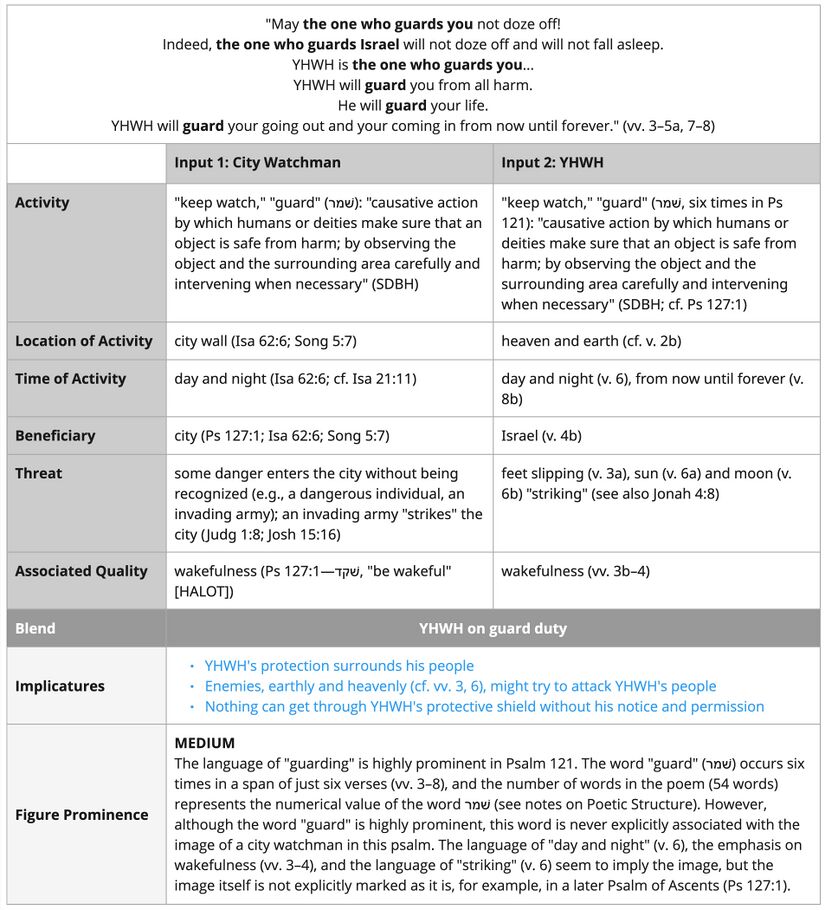
Poetic Feature: Merism
One of the features that makes Psalm 121 unique is its use of merisms.[9] Merism can be defined as "a literary device that uses an abbreviated list to suggest the whole. The most common type of merism cites the poles of a list to suggest everything in between."[10] The following merisms occur in Psalm 121:[11]
- "heaven and earth" (v. 2)
- "during the day... at night" (v. 6)
- "sun... moon" (v. 6)
- "your going out and your coming in" (v. 8a)
- "from now until forever" (v. 8b)
These merisms occur at key structural points in the text. The first merism concludes the first main part of the psalm (v. 2, see poetic Structure), and the last two merisms conclude the psalm as a whole (v. 8). The second and third merisms both occur in v. 6, which stands out as a central verse in the main body of the psalm (vv. 3–8) – it is the only verse in this section that does not have the word "guard" (שׁמר), with this word occurring three times before this verse and three times after it. Verse 6 is also structured as an elaborate chiasm:
a. "during the day" b. "the sun" c. "will not strike you" b. "nor the moon" a. "at night"
The use of merisms at strategic points in the text highlights the all-encompassing nature of YHWH's protection. As the one who made the whole universe (v. 2: "heaven and earth"), YHWH is able to guard his people from every heavenly power (v. 6: "sun... moon") at every moment of the day (v. 6: "during the day... at night") in all that they do (v. 8a: "your going out and your coming in") for all of time (v. 8b: "from now until forever").
Setting
Psalm 121 is very broad in its scope, applying to any number of life situations in which a person might need help and protection. The superscription, "Song of the Ascents", however, connects the psalm to a specific context: pilgrimage to Jerusalem.[12] So e.g., NLT: "A song for pilgrims ascending to Jerusalem." Israelites would travel to Jerusalem to celebrate three annual festivals (Exod 23:15–17; 34:23–24; Lev 23; Deut 16:1–17). The journey to Jerusalem involved many dangers (see v. 3 [foot slipping], v. 6 [sun and moon striking], v. 7 [life-threatening harm]), so people needed "help" for the journey (see vv. 1–2) (see also Exod 34:24). Thus, in light of the superscription, we can read Psalm 121 against the background of the following events:
At the same time, the general nature of Psalm 121 – applying to a variety of possible situations – should be kept in mind. Indeed, the pilgrim's journey to Jerusalem may be a metaphor for a person's journey through life (cf. Ps 1:1 and the conceptual metaphor "Life is a journey"). Just as YHWH guards the Israelite pilgrim on his journey to Jerusalem, so he will guard his people on their journey through life.
Who is Speaking?
As mentioned above, there is a person shift between the two main parts of the psalm. Verses 1–2 use first-person language ("my help"), while vv. 3–8 use second-person language (e.g., "YHWH will guard you"). This shift in person has raised questions about the speech situation in Psalm 121. There is scholarly debate concerning the number of speakers, the points at which speaker shifts occur, and the identity of the addressee(s). For a more detailed discussion of some of the issues, see The Voice(s) in Psalm 121.
In short, we argue that there is probably one speaker throughout the whole psalm. The shift to second-person singular in vv. 3–8 can be explained as an apostrophe, a literary device (often found in Hebrew poetry) whereby a speaker turns to address an imagined group or individual.[13] The psalmist could be addressing himself (cf. Ps 103:1), but it is more likely that he is addressing an imaginary interlocutor. In this regard (and in other regards), Psalm 121 is similar to other didactic (or "wisdom") poems, which will often use second-person singular language to address an imaginary listener (see e.g., Psalm 37).[14] The addressee in vv. 3–8 is Israel, or an individual Israelite (see Participant Analysis), and the second-person address (apostrophe) "permits an escalation of the speaker’s points about God as a guardian."[15]
The following visual tracks the various participants in the psalm, including the speaker and addressee.
The second-person singular addressee is probably Israel, as suggested by the interchange between "the one who guards you" (vv. 3b, 5a) and "the one who guards Israel" (v. 4). The addressee could also be an individual Israelite representing (literarily) the whole people.[16] The use of the singular instead of the plural emphasizes that YHWH's protection is for each and every Israelite.
The use of second-person singular forms to address a group is a common rhetorical device in the Hebrew Bible. The Ten Commandments are expressed as second-person singular commands, because they apply to each and every individual.[17] Similarly, the Book of Deuteronomy alternates between second-person singular and second-person plural. De Regt argues that these shifts in Deuteronomy correlate with the content: "When Israel is addressed about its history... the address forms tend to be plural. But when the subject matter is cultic or ritual (particularly when the commandments are detailed), most of the address forms are singular."[18]
My Help (vv. 1–2)
In the first part of the psalm, the psalmist declares his own personal trust in YHWH. He does so by using a question-and-answer technique, common in didactic poems.[19] His question, "Where will my help come from?" is rhetorical, setting the stage for his answer: "My help is from YHWH."
Poetically, the first sub-section (vv. 1–2) is bound by the repetition of the phrase "my help" (עֶזְרִי), which is actually part of a larger (partial) chiasm in these verses:
A. "I lift" (אשא) B. "the mountains" (between heaven and earth) C. "from where" D. "my help" D. "my help" C. "from YHWH" A. "maker" (עשה, sounds similar to אשא); B. "heaven and earth"
v. 1
| v. | Hebrew | Close-but-Clear |
|---|---|---|
| ss | שִׁ֗יר לַֽמַּ֫עֲל֥וֹת | Song of the Ascents |
| 1a | אֶשָּׂ֣א עֵ֭ינַי אֶל־הֶהָרִ֑ים | I lift my eyes toward the mountains. |
| 1b | מֵ֝אַ֗יִן יָבֹ֥א עֶזְרִֽי׃ | Where will my help come from? |
Expanded Paraphrase
Song of the Ascents, a song for pilgrims travelling up to Jerusalem to celebrate one of the annual festivals. I am setting out on my journey to Jerusalem. The journey is long, and I expect to encounter many dangers. I need divine help for the journey. Without such help, I will not make it there safely. So, I lift my eyes toward the mountains, the place where divine beings dwell and where people go to offer sacrifices to them. Where will my help come from? Who among the divine beings will help me?
Grammatical Diagram
SimpleGrammar
DiscourseUnit [v. 1]
Fragment
Nominal
noun: שִׁיר song
Adjectival
PrepositionalPhrase
Preposition
preposition: לַ belonging to >> of
Object
noun: מַּעֲלוֹת ascents
article: הַ <status="elided"> the
Fragment
Clause
Predicate
verb: אֶשָּׂא I lift
Object
ConstructChain <gloss="my eyes">
noun: עֵינ eyes
suffix-pronoun: ַי me
Adverbial
PrepositionalPhrase
Preposition
preposition: אֶל toward
Object
Nominal
noun: הָרִים mountains
article: הֶ the
Fragment
Clause
Subject
ConstructChain <gloss="my help">
noun: עֶזְר help
suffix-pronoun: ִי me
Predicate
verb: יָבֹא will come
Adverbial
PrepositionalPhrase
Preposition
preposition: מֵ from
Object
particle: אַיִן where
Notes
- The superscription of Psalm 121, Song of the Ascents, differs slightly from the other Psalms of Ascents (Pss 120–134). Whereas the other psalms in the series have שִׁיר הַמַּעֲלוֹת, Psalm 121 has שִׁיר לַמַּעֲלוֹת (a lamed prepositional phrase [לַ] instead of a construct chain [הַ]). Perhaps the reason for the difference is poetic alliteration. Note the similarity in sound between לַמַּעֲלוֹת in the superscription and לַמִּלְחָמָה, the last word of the previous psalm (Ps 120). Also note לַמּוֹט in Psalm 121:3 and the similar sounding phrase at the end of Psalm 121: מֵעַתָּה וְעַד־עוֹלָם (v. 8). Biblical Hebrew authors often chose unique words or phrases for alliteration.[20]
- Lifting one's eyes (נשׂא עינים) is a Hebrew idiom for "looking up," as preliminary to seeing. E.g., "He went out to the field one evening to meditate, and as he looked up (וַיִּשָּׂא עֵינָיו), he saw (וַיַּרְא) camels approaching" (Gen 24:63, NLT). In some contexts, however, "lifting one's eyes >> looking up" describes an "action by which humans turn to a deity or place with the confidence that they will find help and support there" (SDBH). For example, the prophet Ezekiel contrasts a righteous person who "does not eat at the mountain shrines (אֶל הֶהָרִים לֹא אָכָל) or look to (וְעֵינָיו לֹא נָשָׂא) the idols of Israel" (18:6) and a wicked person who "eats at the mountain shrines (אֶל הֶהָרִים אָכַל)" (18:11) and "looks to (נָשָׂא עֵינָיו) the idols" (18:12) (NIV; cf. Ezek 18:15; 23:27; 33:25; Ps 123:1). "Looking to idols" in this context (lit.: "lifting up his eyes to idols") means placing confidence in them and looking to them for help. Similarly, in Psalm 121, the psalmist "looks up" (אֶשָּׂא עֵינַי) "to the mountains" (אֶל הֶהָרִים, cf. Ezek 18:6, 12) for divine help.
- The yiqtol verb "lift" (אֶשָּׂא) describes the action as it happens in real time: "I lift my eyes."[21]
- In the world of the Old Testament, mountains (הָרִים), as the meeting places between heaven and earth, were associated with divine beings. YHWH revealed himself to Abraham on Mount Moriah (Gen 22) and to Moses on Mount Sinai (Exod 3; 19ff), and he chose Mount Zion to be his dwelling place, "his holy mountain" (Ps 3:5; cf. Pss 2:6; 87:1). Other gods were also worshipped on mountains (cf. Deut 12:2; Isa 65:7; Jer 3:6; Ezek 18:6, 11). By looking up to "the mountains" and asking, "Where will my help come from?" the psalmist is effectively asking, "Who among the divine beings will help me?" (cf. the similar rhetorical question in Ps 4:7). The answer is clear in the next verse: "My help comes from YHWH, the one who made heaven and earth."[22] For a more detailed explanation and defense of this interpretation, see The Mountains in Psalm121:1.
- The word מֵאַיִן is an interrogative: where... from? (see e.g., Gen 29:4; 42:7; Num 11:13; etc.). Most translations understand מֵאַיִן in this psalm as introducing a direct question: "I lift up my eyes to the hills. From where does my help come?" (ESV). The grammar by Joüon-Muraoka, however, claims that מֵאַיִן marks an indirect question here, with a verb being elided: "I lift my eyes up to the hills [in order to see] where my help will come from."[23] Others interpret מֵאַיִן as though it were a relative particle, e.g., Zenger: "I lift my eyes to the mountains, from where my help comes."[24] But there is no good reason to adopt these relatively complicated interpretations of מֵאַיִן when the direct-question interpretation makes good sense.[25]
- The noun help (עֵזֶר) describes an "action by which humans or deities provide assistance or support to (other) humans (in both military and non-military contexts) in order to make their life or work or task easier" (SDBH). In the context of a pilgrimage song (v. 1: "a song of the ascents"), where Israelites are traveling on foot to Jerusalem, "help" might refer specifically to protection on the journey (cf. v. 3: "he will not let your foot slip;" v. 6: "the sun will not strike you during the day"). The following Venn Diagram compares the English word "help" to the Hebrew word עֵזֶר.
- Some modern translations translate the yiqtol verb come (יָבֹא) as a habitual present: "Where does my help come from?" (cf. ESV, NIV, KJV, NET, LUT, EÜ). Other translations translate it as a future: "Where will my help come from?" (cf. NJPS, CSB, CEV, GNT, NGÜ, ZÜR, ELB, GNB). Either interpretation is possible. The verbless clause in the following line (unless the verb יָבֹא is elided), which answers the question, might suggest a habitual present interpretation of the yiqtol. On the other hand, the phrase "my help" (עֶזְרִי) in v. 1 implies a real-time, present need for help (some kind of crisis). In this context, a future interpretation of יָבֹא would make the most sense: "(I am in trouble and in need of help.) So I lift my eyes up to the mountains. Where will my help come from?"
v. 2
| v. | Hebrew | Close-but-Clear |
|---|---|---|
| 2a | עֶ֭זְרִי מֵעִ֣ם יְהוָ֑ה | My help is from YHWH, |
| 2b | עֹ֝שֵׂ֗ה שָׁמַ֥יִם וָאָֽרֶץ׃ | the one who made heaven and earth. |
Expanded Paraphrase
My help is only from YHWH, the one true God, the one who made heaven and earth, the one who is greater than all other divine beings and who alone can protect me on my journey from earthly and heavenly dangers.
Grammatical Diagram
SimpleGrammar
DiscourseUnit [v. 2]
Fragment
Clause
Subject
ConstructChain <gloss="my help">
noun: עֶזְר help
suffix-pronoun: ִי me
Predicate
verb: is
Complement
PrepositionalPhrase
Preposition
preposition: מֵעִם from
Object
Apposition
noun: יְהוָה YHWH
Nominal
Clause
Predicate
verb-participle: עֹשֵׂה the one who made
Object
noun: שָׁמַיִם heaven
conjunction: וָ and
noun: אָרֶץ earth
Notes
- The preposition from (מֵעִם) is a compound preposition (מִן "from" + עִם "with") that indicates the "origin" of the help (DCH). "Help," which was with (עִם) YHWH, comes from (מֵ) him and to the psalmist.[26] The preposition corresponds to the interrogative "from where" (מֵאַיִן) in the previous clause and introduces the answer to the psalmist's question.
- The phrase heaven and earth (שָׁמַיִם וָאָרֶץ) is "a more or less fixed phrase... equivalent to a single lexical item: the totality of God's creation" (SDBH). The phrase occurs three times within the Song of Ascents (see also Pss 124:8; 134:3).
Your Guard (vv. 3–8)
The second main part of the psalm (vv. 3–8) uses second-person language and features the keyword "guard." On the shift to second-person language, see above.
Verses 3–8 subdivide into three sections.
- The first sub-section (vv. 3–4) is bound by the repetition of the rare word "doze off" (יָנוּם). The use of negators ("not...not...not...not") also binds these verses together.
- The second sub-section (vv. 5–6) is bound by its imagery: the "shade" mentioned in v. 5 gives protection from the "sun" mentioned in v. 6.
- The third sub-section (vv. 7–8) is bound by the especially dense repetition of ישׁמר (yiqtol), which occurs in every clause. The two verses in this section also have the same beginning: יְהוָה יִשְׁמָרְ.
v. 3
| v. | Hebrew | Close-but-Clear |
|---|---|---|
| 3a | אַל־יִתֵּ֣ן לַמּ֣וֹט רַגְלֶ֑ךָ | May he not let your foot slip! |
| 3b | אַל־יָ֝נ֗וּם שֹֽׁמְרֶֽךָ׃ | May the one who guards you not doze off! |
Expanded Paraphrase
Here is what I would say to someone in my position – what I would say to anyone who looks to YHWH for help: May he, i.e., YHWH, not let your foot slip on your journey – whether your pilgrim journey to Jerusalem or your metaphorical journey through life, which is a kind of pilgrimage – so that you suffer hardship! May YHWH, the one who guards you, not doze off and fall asleep, leaving you vulnerable to harm!
Grammatical Diagram
SimpleGrammar
DiscourseUnit [v. 3]
Fragment
Clause
Predicate
verb: יִתֵּן may he give >> may he let
Object
ConstructChain <gloss="your foot">
noun: רַגְל foot
suffix-pronoun: ֶךָ you
Adverbial
PrepositionalPhrase <gloss="slip">
Preposition
preposition: לַ to
Object
Nominal
noun: מּוֹט slipping
article: הַ <status="elided"> the
Adverbial
adverb: אַל not
Fragment
Clause
Subject
ConstructChain
Nominal
verb-participle: שֹׁמְר the one who guards
suffix-pronoun: ֶךָ you
Predicate
verb: יָנוּם may doze off
Adverbial
adverb: אַל not
Notes
- One of the key issues in this verse is whether the clauses are declarative – "he will not..." (ESV) – or directive – "May he not..." (NET). See The Mood of Psalm121:3 for a detailed discussion of the issue. In short, we argue that the clauses in v. 3 are probably directive, expressing a wish, prayer, or blessing: May he not.... In the end, the most decisive argument for this interpretation is based on the use of the negator אַל instead of לֹא.[27]
- The phrase translated let... slip (יִתֵּן לַמּוֹט; also in Ps 66:9) is, literally, "give to the slipping." The verb "give/let" (נתן), followed by an infinitive (or, in this case, a noun communicating a verbal idea), is a Biblical Hebrew way of saying "allow X-event to happen." See e.g., Gen 20:6—"I did not let you touch her (לֹא נְתַתִּיךָ לִנְגֹּעַ אֵלֶיהָ)" (NIV; see DCH נתן entry 7). The article on the word "slip" (לַמּוֹט) represents the generic use of the article, which is often used with "abstract terms, referring to attributes, qualities, or states" (IBHS §13.5.1g). In this case, it is used with an event ("slipping").
- Life is like a journey (cf. Ps 1:1), and losing one's footing ("slipping") means encountering hardship on the journey.[28]
- The mention of your foot in v. 3a is poetically significant. Recall that the first section of the psalm also began with the mention of a body part: "my eyes." In fact, the first verse of each sub-section in the psalm in contains a reference to a body part: "eyes" (v. 1), "foot" (v. 3), "right hand" (v. 5), "life" (lit.: "throat") (v. 7).[29] In this way, Psalm 121 affirms YHWH's protection over a person's entire being, represented by the person's "foot" (v. 3), "right hand" (v. 5), and "life" (lit.: "throat") (v. 7). This protection, however, is not for anyone and everyone, but for those whose "eyes" are fixed confidently on YHWH (v. 1). The following visual highlights references to body parts in the psalm.
- A city "guard" or "watchman" (שֹׁמֵר) on the night shift (cf. Isa 21:11–12) might be tempted to "doze off" (נוּם) or "fall asleep" (ישׁן) on the job. But "the one who guards Israel never dozes or falls asleep." The verb doze off (נוּם) only occurs six times in the OT, and two of them are in this psalm (see also Isa 5:27; 56:10; Nah 3:18; Ps 76:6; cf. 4Q424, 3.5). The Septuagint translates the verb here with a form of the verb νυστάζω, which means "to be half asleep, doze" (LSJ). Most English translations use the word "slumbers," but "dozes" might be a better natural-language equivalent (GNT).[30] One can speak of a watchman "dozing off" on the job. This meaning of the verb is supported by a non-biblical psalm from Qumran (Ps 155), which describes a sequence of sleeping and waking, beginning with the verb נוּם: "I dozed off (נמתי) and fell asleep (ואישנה); I dreamt (חלמתי) and woke up (הקיצותי)."[31]
- There is an Egyptian parallel to this text that describes an Egyptian god staying awake and keeping watch over his flock: "Hail to you, who created all this... who spends the night awake when all the world sleeps, seeking what is good for his flock; Amun, abiding in all things, Atum Harakhte. Praise to you with what they all say to you: They rejoice in you because you have labored with us, they kiss the earth before you because you have created us."[32]
- On the word guard, see above.
v. 4
| v. | Hebrew | Close-but-Clear |
|---|---|---|
| 4a | הִנֵּ֣ה לֹֽא־יָ֭נוּם וְלֹ֣א יִישָׁ֑ן | Indeed, the one who guards Israel |
| 4b[33] | שׁ֝וֹמֵ֗ר יִשְׂרָאֵֽל׃ | will not doze off and will not fall asleep. |
Expanded Paraphrase
Indeed, you don't have to worry about that happening, because YHWH, the one who guards Israel, will not doze off and will not fall asleep.
Grammatical Diagram
SimpleGrammar
DiscourseUnit [v. 4]
Fragment
particle: הִנֵּה indeed
Fragment
Clause
Subject
ConstructChain
Nominal
verb-participle: שׁוֹמֵר the one who guards
noun: יִשְׂרָאֵל Israel
Predicate
Predicate
verb: יָנוּם will doze off
Adverbial
adverb: לֹא not
Conjunction
conjunction: וְ and
Predicate
verb: יִישָׁן fall asleep
Adverbial
adverb: לֹא not
Adverbial <status="alternative">
PrepositionalPhrase
Preposition
preposition: בַּ in <status="alternative emendation">
Object
Nominal
noun: לָּיְלָה night <status="alternative emendation">
article: הַ the <status="alternative emendation">
Notes
- The discourse marker indeed (הִנֵּה) at the beginning of v. 4 signals to the reader that the information in v. 4 is "noteworthy or newsworthy with respect to the other discourse active information."[34] Specifically, it signals that the content of v. 4 "modifies the content or implicatures of statements in the preceding cotext," providing either confirmation, elaboration, or a clarification.[35] The previous verse expressed a wish, or a blessing ("May he..."), with the implicit possibility that it might not come true. But v. 4 corrects this possible misunderstanding and affirms, without doubt, that YHWH will not doze off or fall asleep.
- Verse 4b, together with v. 5a, constitute the psalm's numeric and thematic center: the one who guards Israel (v. 4b) / YHWH is the one who guards you (v. 5a). These two lines are flanked on either side by seven lines and 25 words. These two lines also stand out becayse they are exceptionally short – the two shortest lines in the psalm in terms of word and syllable count (2 words, 5–6 syllables).[36] Furthermore, these two lines form a chiasm:[37]
a. "one who guards" b. "Israel" (proper name) b. "YHWH" (proper name) a. "one who guards"
- The centrality of vv. 4b–5a brings into sharp focus the psalm's main theme ("guarding") and its two main participants ("Israel" and "YHWH"). The whole message of the psalm can be summarized with these few words: "YHWH guards Israel."
v. 5
| v. | Hebrew | Close-but-Clear |
|---|---|---|
| 5a[38] | יְהוָ֥ה שֹׁמְרֶ֑ךָ | YHWH is the one who guards you. |
| 5b | יְהוָ֥ה צִ֝לְּךָ֗ עַל־יַ֥ד יְמִינֶֽךָ׃ | YHWH is your shade over your right hand. |
Expanded Paraphrase
On your journey to Jerusalem (and your journey through all of life), YHWH is your guardian, the one who guards you. He watches over you like a city watchman watching over the well-being of a city, or like a shepherd watching over his flock. As you travel under the open sky, you need protection. YHWH is your protective shade over your right hand, over the south side of your body, where the sun shines the hottest.
Grammatical Diagram
SimpleGrammar
DiscourseUnit [v. 5]
Fragment
Clause
Subject
noun: יְהוָה YHWH
Predicate
verb: is
Complement
ConstructChain
Nominal
verb-participle: שֹׁמְר the one who guards
suffix-pronoun: ֶךָ you
Fragment
Clause
Subject
noun: יְהוָה YHWH
Predicate
verb: is
Complement
ConstructChain <gloss="your shade">
Nominal
noun: צִלְּ shade
Adjectival
PrepositionalPhrase <gloss="over your right hand">
Preposition
preposition: עַל over
Object
ConstructChain
noun: יַד hand
noun: יְמִינ right hand
suffix-pronoun: ֶךָ you
suffix-pronoun: ךָ you
Notes
- In terms of information structure, the verbless clauses in v. 5a and v. 5b are probably predicational: "YHWH (topic) is your guard (predicate). YHWH (topic) is your shade (predicate)." Alternatively, it is plausible that these verbless clauses are specificational (rather than predicational): "(Who is the one who guards you?) YHWH is the one who guards you. YHWH is your shade" (cf. vv. 1–2).
- Verse 5b describes YHWH as shade (צֵל) for his people, protecting them from the sun's scorching heat (see v. 6a; cf. references to the "shade" of trees in Judg 9:15; Ps 80:11; Jonah 4:5–6; etc.). The following chart explores this image:
- Some English translations render the phrase עַל יַד יְמִינֶךָ as "at your right hand" (NET, NIV) or "by your side" (GNT, CSB). Similarly, Mena categorizes the use of עַל in this verse as a "contingent locative: The TR [=YHWH] is next to the LM [=your right hand] in close proximity."[39] But in this context, where protection from the sun is in view (see v. 6), עַל probably conveys its basic sense of "over" or "above." As Zenger writes, "The preposition עַל is to be translated here not as 'at the side of' or 'at your right hand' but as 'over,' since צֵל, 'shade,' evokes the idea of a 'sheltering umbrella' over the human being while he or she is traveling 'day and night.'"[40]
- The construct phrase יַד יְמִינֶךָ means "the hand of [your] right-hand side, i.e. [your] right hand" (DCH)[41] and is interchangeable with יְמִינְךָ by itself.[42] A person's "right hand" is their "strong hand," and YHWH's position at or over a person's "right hand" elsewhere communicates his protective presence (cf. Ps 16:8; 109:3). In this context, where it communicates his protection from the sun (v. 6), "right hand" takes on additional significance, since the right hand was "the side of the human body which is to the south when facing the direction of the rising sun" (SDBH, cf. Ps 89:13, where יָמִין means "south"). Israel is in the Northern Hemisphere, just north of the equator, where the sun is always in the southern part of the sky, especially at midday. As a result, southern exposure gets the most direct sunlight, and shade would be most beneficial on the southern side of one's body, on one's "right" (יָמִין).
v. 6
| v. | Hebrew | Close-but-Clear |
|---|---|---|
| 6a | יוֹמָ֗ם הַשֶּׁ֥מֶשׁ לֹֽא־יַכֶּ֗כָּה | During the day, the sun will not strike you, |
| 6b | וְיָרֵ֥חַ בַּלָּֽיְלָה׃ | nor the moon at night. |
Expanded Paraphrase
Because YHWH is your shade, during the day, the sun will not strike you and harm you with its heat, nor will the moon strike you at night, causing you to have a skin disease or an epileptic fit. In other words, YHWH, the one who made heaven and earth, will protect you from the most threatening forces of heaven.
Grammatical Diagram
SimpleGrammar
DiscourseUnit [v. 6]
Fragment
ClauseCluster
Clause
Subject
Nominal
noun: שֶּׁמֶשׁ sun
article: הַ the
Predicate
verb: יַכֶּ will strike
Object
suffix-pronoun: ֶכָּה you
Adverbial
adverb: לֹא not
Adverbial
adverb: יוֹמָם during the day
Conjunction
conjunction: וְ and
Clause
Subject
noun: יָרֵחַ moon
Predicate
verb: יַכֶּ will strike <status="elided">
Object <status="elided">
suffix-pronoun: ֶכָּה you <status="elided">
Adverbial <status="elided">
adverb: לֹא not
Adverbial
PrepositionalPhrase <gloss="at night">
Preposition
preposition: בַּ in
Object
Nominal
noun: לָּיְלָה night
article: הַ the
Notes
- The non-default word order in v. 6 creates a chiasm:[43]
A. "during the day"; B. "the sun"; C. "will not strike you"; B'. "the moon"; A'. "at night".
- Lunn argues that the word order in this verse might be marking a literary peak in the psalm.[44] Indeed, v. 6 further stands out as being the only verse in vv. 3–8 that does not have the word "guard" (שׁמר). This word occurs three times before v. 6 and three times after it.
- The sun can strike those who are exposed to its heat (cf. Isa 49:10; Jonah 4:8), just like an invading army can "strike" a city (Judg 1:8; Josh 15:16). But the one who "guards" Israel, like someone guarding a city, will give protection from the sun. In addition to its literal sense – sunstroke would have been a real threat for someone journeying to Jerusalem – "the sun" (together with "the moon") might represent spiritual, heavenly powers. In the ancient world, people imbued the sun and moon with divine powers, and many people worshipped the sun and the moon.[45] Thus, whereas v. 3 affirms YHWH's protection from earthly threats (foot slipping), v. 6 would affirm YHWH's protection from heavenly threats. The one who made "heaven and earth" (v. 2) guards Israel from all earthly and heavenly danger.
- In the ancient world (Ancient Near Eastern and Graeco-Roman), certain dangers were associated with the moon, especially skin diseases and epilepsy: "When the moon is full, man is exposed to its rays and, when unprotected, he is in great danger of contracting an abhorrent skin disease like leprosy; blindness is also possible. When the moon is new, or rather during the moonless nights at the end of the month, an epileptic fit caused by demonic powers threatens him."[46]
v. 7
| v. | Hebrew | Close-but-Clear |
|---|---|---|
| 7a | יְֽהוָ֗ה יִשְׁמָרְךָ֥ מִכָּל־רָ֑ע | YHWH will guard you from all harm. |
| 7b | יִ֝שְׁמֹ֗ר אֶת־נַפְשֶֽׁךָ׃ | He will guard your life. |
Expanded Paraphrase
YHWH will guard you from all heavenly and earthly harm. He will guard your life.
Grammatical Diagram
SimpleGrammar
DiscourseUnit [v. 7]
Fragment
Clause
Subject
noun: יְהוָה YHWH
Predicate
verb: יִשְׁמָרְ will guard
Object
suffix-pronoun: ךָ you
Adverbial
PrepositionalPhrase
Preposition
preposition: מִ from
Object
Nominal
noun: רָע harm
quantifier: כָּל all
Fragment
Clause
Predicate
verb: יִשְׁמֹר he will guard
Object
ConstructChain <gloss="your life">
Nominal
particle: אֶת
noun: נַפְשׁ life
suffix-pronoun: ֶךָ you
Notes
- A key issue in this verse is the interpretation of the verbal semantics. Most modern translations interpret the clauses in vv. 7–8 as indicatives: YHWH will guard you.[47] Some translations, however, interpret them as modal, expressing a wish or blessing: "May YHWH guard you."[48] The preceding context (esp. vv. 5–6) and the subject-verb word order in vv. 7–8 suggest that the yiqtols in these verses are indicative.[49]
- The subject-predicate word order in vv. 7a, 8a matches the subject-predicate word order in v. 5. Note especially the similarity between "YHWH is the one who guards you" (יְהוָה שֹׁמְרֶךָ) in v. 5a (the beginning of a poetic section) and "YHWH will guard you" (יְהוָה יִשְׁמָרְךָ) in v. 7a (the beginning of the next poetic section). Thus, the non-default subject-verb word order in vv. 7–8 is part of a poetic pattern. It might also be that the subject-verb word order in vv. 7–8 is necessary to mark these clauses as indicative (or assertive). Verb-subject word order might have implied directive (or projective) semantics: "May YHWH guard..."[50]
- On the meaning and poetic significance of the phrase your life, see the note on "your foot" and body parts in v. 3.
v. 8
| v. | Hebrew | Close-but-Clear |
|---|---|---|
| 8a | יְֽהוָ֗ה יִשְׁמָר־צֵאתְךָ֥ וּבוֹאֶ֑ךָ | YHWH will guard your going out and your coming in |
| 8b | מֵֽ֝עַתָּ֗ה וְעַד־עוֹלָֽם׃ | from now until forever. |
Expanded Paraphrase
YHWH will guard you in all that you do – in your going out and your coming in – from now until forever.
Grammatical Diagram
SimpleGrammar
DiscourseUnit [v. 8]
Fragment
Clause
Subject
noun: יְהוָה YHWH
Predicate
verb: יִשְׁמָר will guard
Object
Nominal
ConstructChain <gloss="your going">
Nominal
Clause
Predicate
verb-infinitive: צֵאתְ going out
suffix-pronoun: ךָ you
Conjunction
conjunction: וּ and
Nominal
ConstructChain <gloss="your coming in">
Nominal
Clause
Predicate
verb-infinitive: בוֹא coming in
suffix-pronoun: ֶךָ you
Adverbial
Adverbial
PrepositionalPhrase
Preposition
preposition: מֵ from
Object
particle: עַתָּה now
Conjunction
conjunction: וְ and
Adverbial
PrepositionalPhrase
Preposition
preposition: עַד until
Object
particle: עוֹלָם forever
Notes
- The compound phrase going out and coming in describes one's "daily activities."[51] Elsewhere, the two terms are opposites. E.g., Gen 31:33—"And he went out (וַיֵּצֵא) of Leah’s tent and entered (וַיָּבֹא) Rachel’s" (ESV). But in Ps 121, they function as a merism (cf. "heaven and earth" in v. 2), encompassing all the activities a person might do. As Chrysostom writes, "Here, I agree, he refers to all of life: all of life is covered by this, entrances and exits."[52] Thus, the NET translates, "The LORD will protect you in all you do."
Legends
Grammatical diagram
| Visualization | Description |
|---|---|
| The clause is represented by a horizontal line with a vertical line crossing through it, separating the subject and the verb. | |
| The object is indicated by a vertical line that does not cross the horizontal line of the clause. Infinitives and participles may also have objects. If the direct object marker (d.o.m.) is present in the text, it appears in the diagram immediately before the object. If the grammar includes a secondary object, the secondary object will appear after the object, separated by another vertical line that does not cross the horizontal line of the clause. | |
| The subject complement follows the verb (often omitted in Hebrew) separated with a line leaning toward the right. It can be a noun, a whole prepositional phrase or an adjective. The later two appear modifying the complement slot. | |
| When a noun further describes or renames the object, it is an object complement. The object complement follows the object separated by a line leaning toward the right. | |
| In a construct chain, the noun in the absolute form modifies the noun in the construct form. | |
| Participles are indicated in whatever position in the clause they are in with a curved line before the participle. Participles can occur as nominal, where they take the place of a noun, predicate, where they take the place of a verb, or attributive, where they modify a noun or a verb similar to adjectives or adverbs. | |
| Infinitives are indicated by two parallel lines before the infinitive that cross the horizontal line. Infinitive constructs can appear as the verb in an embedded clause. Infinitive absolutes typically appear as an adverbial. | |
| The subject of the infinitive often appears in construct to it. In this situation, the infinitive and subject are diagrammed as a construct chain. | |
| The object of the infinitive is indicated by a vertical line that does not cross the horizontal line of the infinitival clause. | |
| Modifiers are represented by a solid diagonal line from the word they modify. They can attach to verbs, adjectives, or nouns. If modifying a verb or adjective, it is an adverb, but if modifying a noun, it is an adjective, a quantifier, or a definite article. If an adverb is modifying a modifier, it is connected to the modifier by a small dashed horizontal line. | |
| Adverbials are indicated by a dashed diagonal line extending to a horizontal line. These are nouns or infinitives that function adverbially (modifying either a verb or a participle), but are not connected by a preposition. | |
| Prepositional phrases are indicated by a solid diagonal line extending to a horizontal line. The preposition is to the left of the diagonal line and the dependent of the preposition is on the horizontal line. They can modify verbs (adverbial) or nouns (adjectival). | |
| Embedded clauses are indicated by a "stand" that looks like an upside-down Y. The stand rests in the grammatical position that the clause fulfills. Extending from the top of the stand is a horizontal line for the clause. If introduced by a complementizer, for example כִּי, the complementizer appears before the stand. Embedded clauses can stand in the place of any noun. | |
| When clauses are joined by a conjunction, they are compound clauses. These clauses are connected by a vertical dotted line. The conjunction is placed next to the dotted line. | |
| Within a clause, if two or more parts of speech are compound, these are represented by angled lines reaching to the two compound elements connected by a solid vertical line. If a conjunction is used, the conjunction appears to the left of the vertical line. Almost all parts of speech can be compound. | |
| Subordinate clauses are indicated by a dashed line coming from the line dividing the subject from the predicate in the independent clause and leading to the horizontal line of the subordinate clause. The subordinating conjunction appears next to the dashed line. | |
| Relative clauses also have a dashed line, but the line connects the antecedent to the horizontal line of the relative clause. The relative particle appears next to the dashed line. | |
| Sentence fragments are represented by a horizontal line with no vertical lines. They are most frequently used in superscriptions to psalms. They are visually similar to discourse particles and vocatives, but most often consist of a noun phrase (that does not refer to a person or people group) or a prepositional phrase. | |
| In the body of the psalm, a horizontal line by itself (with no modifiers or vertical lines) can indicate either a discourse particle or a vocative (if the word is a noun referring to a person or people group). A discourse particle is a conjunction or particle that functions at the discourse level, not at the grammatical level. Vocatives can appear either before or after the clause addressed to them, depending on the word order of the Hebrew. | |
| Apposition is indicated by an equal sign equating the two noun phrases. This can occur with a noun in any function in a sentence. |
| Hebrew text colors | |
|---|---|
| Default preferred text | The default preferred reading is represented by a black line. The text of the MT is represented in bold black text. |
| Dispreferred reading | The dispreferred reading is an alternative interpretation of the grammar, represented by a pink line. The text of the MT is represented in bold pink text, while emendations and revocalizations retain their corresponding colors (see below). |
| Emended text | Emended text, text in which the consonants differ from the consonants of the Masoretic text, is represented by bold blue text, whether that reading is preferred or dispreferred. |
| Revocalized text | Revocalized text, text in which only the vowels differ from the vowels of the Masoretic text, is represented by bold purple text, whether that reading is preferred or dispreferred. |
| (Supplied elided element) | Any element that is elided in the Hebrew text is represented by bold gray text in parentheses. |
| ( ) | The position of a non-supplied elided element is represented by empty black parentheses. For example, this would be used in the place of the noun when an adjective functions substantivally or in the place of the antecedent when a relative clause has an implied antecedent. |
| Gloss text colors | |
|---|---|
| Gloss used in the CBC | The gloss used in the Close-but-Clear translation is represented by bold blue text. |
| Literal gloss >> derived meaning | A gloss that shows the more literal meaning as well as the derived figurative meaning is represented in blue text with arrows pointing towards the more figurative meaning. The gloss used in the CBC will be bolded. |
| Supplied elided element | The gloss for a supplied elided element is represented in bold gray text. |
Shapes and colours on grammatical diagram
| Visualization | Description |
|---|---|
| The prepositional phrase is indicated by a solid green oval. | |
| The construct chain is indicated by a solid yellow oval. | |
| When the conjunction ו appears at the phrase-level (not clause-level), it is indicated by a solid light purple oval. | |
| The article is indicated by a solid blue oval. |
Expanded paraphrase
(For more information, click "Expanded Paraphrase Legend" below.)
| Expanded paraphrase legend | |
|---|---|
| Close but Clear (CBC) translation | The CBC, our close but clear translation of the Hebrew, is represented in bold text. |
| Assumptions | Assumptions which provide background information, presuppositions, entailments, and inferences are represented in italics. |
Bibliography
- Assmann, Jan. Ägyptische Hymnen und Gebete. Orbis Biblicus et Orientalis. Freiburg/Göttingen: Universitäts Verlag/Vandenhoeck & Ruprecht, 1999.
- Baethgen, Friedrich. Die Psalmen. Göttingen: Vandenhoeck und Ruprecht, 1904.
- Berlin, Adele, Avigdor Shinan, and Benjamin D. Sommer. The JPS Bible Commentary: Psalms 120–150: תהלים קכ–קנ. University of Nebraska Press, 2023.
- Bojowlad, Stefan. “Eine Ägyptische Parallele Für Ps 121,3-4.” Biblische Notizen 191 (2021): 59–63.
- Bullinger, E.W. Figures of Speech Used in the Bible. Grand Rapids: Baker Book House, 1968.
- Chrysostom, John. St. John Chrysostom Commentary on the Psalms. Translated by Robert C. Hill. Brookline, Mass: Holy Cross Orthodox Press, 1998.
- Creach, Jerome. “Psalm 121.” Interpretation: A Journal of Bible and Theology 50, no. 1 (1996): 47–51.
- Emmendörffer, Michael. “Psalm 121 – Jahwe als Wächter des Lebens. Ein Dokument später Psalmenfrömmigkeit.” In Über Psalmen: Interdisziplinäre Studien zum Psalter und seiner Rezeption, edited by Michael Pietsch and Christian Rose, 11–22. Theologische Akzente 11. Stuttgart: Kohlhammer, 2025.
- Fokkelman, J.P. Major Poems of the Hebrew Bible: At the Interface of Prosody and Structural Analysis (Vol 2: 85 Psalms and Job 4–14). Vol. 2. Studia Semitica Neerlandica. Van Gorcum, 2000.
- Gentry, Peter J. 1998. “The System of the Finite Verb in Classical Hebrew.” Hebrew Studies 39: 7–39.
- Gentry, Peter J., and Stephen J. Wellum. Kingdom Through Covenant: A Biblical-Theological Understanding of the Covenants. Wheaton: Crossway, 2012.
- Goldingay, John. Psalms: Psalms 90-150. Vol. 3. BCOT. Grand Rapids: Baker Academic, 2008.
- Kennicott, Benjamin. Vetus testamentum hebraicum : cum variis lectionibus, 1776.
- Longacre, Drew. “The 11Q5 Psalter as a Scribal Product: Standing at the Nexus of Textual Development, Editorial Processes, and Manuscript Production.” ZAW 134, no. 1 (2022): 85–111.
- Longman III, Tremper. “Merism.” Dictionary of the Old Testament Wisdom, Poetry & Writings. Edited by Tremper Longman III and Peter Enns. Downers Grove: IVP Academic, 2008.
- Lunn, Nicholas P. Word-Order Variation in Biblical Hebrew Poetry: Differentiating Pragmatics and Poetics. Paternoster Biblical Monographs. Milton Keynes: Paternoster, 2006.
- van der Lugt, Pieter. Cantos and Strophes in Biblical Hebrew Poetry III: Psalms 90–150 and Psalm 1. Vol. 3. Oudtestamentische Studiën 63. Leiden: Brill, 2013.
- Maré, Leonard P. “Psalm 121: Yahweh’s Protection against Mythological Powers.” Old Testament Essays (New Series) 19, no. 2 (2006): 712–722.
- Miller-Naudé, Cynthia L., and C.H.J. van der Merwe. “הִנֵּה and Mirativity in Biblical Hebrew.” Hebrew Studies 52 (2011): 53–81.
- Notarius, Tania. The Verb in Archaic Biblical Poetry: A Discursive, Typological, and Historical Investigation of the Tense System. Leiden: Brill, 2013.
- de Regt, Lénart J. Linguistic Coherence in Biblical Hebrew Texts. Revised and Extended edition. Perspectives on Hebrew Scriptures and its Contexts 28. Piscataway: Gorgias Press, 2019.
- Rendsburg, Gary. How the Bible Is Written. Peabody: Hendrickson, 2019.
- Robar, Elizabeth. “Morphology and Markedness: On Verb Switching in Hebrew Poetry.” Journal for Semitics 30, no. 2 (2021): 1–17.
- Sanders, James A. The Psalms Scroll of Qumrân Cave 11 (11QPsa). DJD 4. Oxford: Clarendon Press, 1965.
- Schmitt, Armin. “Zum literarischen und theologischen Profil von Ps 121.” Biblische Notizen 97 (1999): 55–84.
- Sjörs, Ambjörn. Historical Aspects of Standard Negation in Semitic. Studies in Semitic Languages and Linguistics 91. Leiden/Boston: Brill, 2018.
- Staszak, Martin. The Preposition Min. Beiträge zur Wissenschaft vom Alten und Neuen Testament (BWANT) 246. Stuttgart: Kohlhammer, 2024.
- Stol, Marten. Epilepsy in Babylonia. Cuneiform Monographs 2. Groningen: Styx Publications, 1993.
- Taylor, Richard A. The Syriac Peshitta Bible with English Translation. Piscataway: Gorgias Press, 2020.
- Theodoret. Commentary on the Psalms. Translated by Robert C. Hill. The Fathers of the Church 101-102. Washington, D.C.: Catholic University of America Press, 2001.
- Weber, Beat. Werkbuch Psalmen II: Die Psalmen 73 Bis 150. 2., Aktualisierte Auflage. Stuttgart: Verlag W. Kohlhammer, 2016.
- Willis, John T. “Psalm 121 As a Wisdom Poem.” Hebrew Annual Review 11 (1987): 435–51.
- Witthoff, David J. "The Relationships of the Senses of נֶפֶשׁ in the Hebrew Bible: A Cognitive Linguistics Perspective." PhD Dissertation, University of Stellenbosch, 2021.
- Zenger, Erich. “Psalm 121.” In Psalms 3: A Commentary on Psalms 101-150, by Frank Lothar Hossfeld and Erich Zenger, 315–331. Hermeneia. Augsburg Fortress Publishers, 2011.
Footnotes
121
Legends
Grammatical diagram
| Visualization | Description |
|---|---|
| The clause is represented by a horizontal line with a vertical line crossing through it, separating the subject and the verb. | |
| The object is indicated by a vertical line that does not cross the horizontal line of the clause. Infinitives and participles may also have objects. If the direct object marker (d.o.m.) is present in the text, it appears in the diagram immediately before the object. If the grammar includes a secondary object, the secondary object will appear after the object, separated by another vertical line that does not cross the horizontal line of the clause. | |
| The subject complement follows the verb (often omitted in Hebrew) separated with a line leaning toward the right. It can be a noun, a whole prepositional phrase or an adjective. The later two appear modifying the complement slot. | |
| When a noun further describes or renames the object, it is an object complement. The object complement follows the object separated by a line leaning toward the right. | |
| In a construct chain, the noun in the absolute form modifies the noun in the construct form. | |
| Participles are indicated in whatever position in the clause they are in with a curved line before the participle. Participles can occur as nominal, where they take the place of a noun, predicate, where they take the place of a verb, or attributive, where they modify a noun or a verb similar to adjectives or adverbs. | |
| Infinitives are indicated by two parallel lines before the infinitive that cross the horizontal line. Infinitive constructs can appear as the verb in an embedded clause. Infinitive absolutes typically appear as an adverbial. | |
| The subject of the infinitive often appears in construct to it. In this situation, the infinitive and subject are diagrammed as a construct chain. | |
| The object of the infinitive is indicated by a vertical line that does not cross the horizontal line of the infinitival clause. | |
| Modifiers are represented by a solid diagonal line from the word they modify. They can attach to verbs, adjectives, or nouns. If modifying a verb or adjective, it is an adverb, but if modifying a noun, it is an adjective, a quantifier, or a definite article. If an adverb is modifying a modifier, it is connected to the modifier by a small dashed horizontal line. | |
| Adverbials are indicated by a dashed diagonal line extending to a horizontal line. These are nouns or infinitives that function adverbially (modifying either a verb or a participle), but are not connected by a preposition. | |
| Prepositional phrases are indicated by a solid diagonal line extending to a horizontal line. The preposition is to the left of the diagonal line and the dependent of the preposition is on the horizontal line. They can modify verbs (adverbial) or nouns (adjectival). | |
| Embedded clauses are indicated by a "stand" that looks like an upside-down Y. The stand rests in the grammatical position that the clause fulfills. Extending from the top of the stand is a horizontal line for the clause. If introduced by a complementizer, for example כִּי, the complementizer appears before the stand. Embedded clauses can stand in the place of any noun. | |
| When clauses are joined by a conjunction, they are compound clauses. These clauses are connected by a vertical dotted line. The conjunction is placed next to the dotted line. | |
| Within a clause, if two or more parts of speech are compound, these are represented by angled lines reaching to the two compound elements connected by a solid vertical line. If a conjunction is used, the conjunction appears to the left of the vertical line. Almost all parts of speech can be compound. | |
| Subordinate clauses are indicated by a dashed line coming from the line dividing the subject from the predicate in the independent clause and leading to the horizontal line of the subordinate clause. The subordinating conjunction appears next to the dashed line. | |
| Relative clauses also have a dashed line, but the line connects the antecedent to the horizontal line of the relative clause. The relative particle appears next to the dashed line. | |
| Sentence fragments are represented by a horizontal line with no vertical lines. They are most frequently used in superscriptions to psalms. They are visually similar to discourse particles and vocatives, but most often consist of a noun phrase (that does not refer to a person or people group) or a prepositional phrase. | |
| In the body of the psalm, a horizontal line by itself (with no modifiers or vertical lines) can indicate either a discourse particle or a vocative (if the word is a noun referring to a person or people group). A discourse particle is a conjunction or particle that functions at the discourse level, not at the grammatical level. Vocatives can appear either before or after the clause addressed to them, depending on the word order of the Hebrew. | |
| Apposition is indicated by an equal sign equating the two noun phrases. This can occur with a noun in any function in a sentence. |
| Hebrew text colors | |
|---|---|
| Default preferred text | The default preferred reading is represented by a black line. The text of the MT is represented in bold black text. |
| Dispreferred reading | The dispreferred reading is an alternative interpretation of the grammar, represented by a pink line. The text of the MT is represented in bold pink text, while emendations and revocalizations retain their corresponding colors (see below). |
| Emended text | Emended text, text in which the consonants differ from the consonants of the Masoretic text, is represented by bold blue text, whether that reading is preferred or dispreferred. |
| Revocalized text | Revocalized text, text in which only the vowels differ from the vowels of the Masoretic text, is represented by bold purple text, whether that reading is preferred or dispreferred. |
| (Supplied elided element) | Any element that is elided in the Hebrew text is represented by bold gray text in parentheses. |
| ( ) | The position of a non-supplied elided element is represented by empty black parentheses. For example, this would be used in the place of the noun when an adjective functions substantivally or in the place of the antecedent when a relative clause has an implied antecedent. |
| Gloss text colors | |
|---|---|
| Gloss used in the CBC | The gloss used in the Close-but-Clear translation is represented by bold blue text. |
| Literal gloss >> derived meaning | A gloss that shows the more literal meaning as well as the derived figurative meaning is represented in blue text with arrows pointing towards the more figurative meaning. The gloss used in the CBC will be bolded. |
| Supplied elided element | The gloss for a supplied elided element is represented in bold gray text. |
Shapes and colours on grammatical diagram
| Visualization | Description |
|---|---|
| The prepositional phrase is indicated by a solid green oval. | |
| The construct chain is indicated by a solid yellow oval. | |
| When the conjunction ו appears at the phrase-level (not clause-level), it is indicated by a solid light purple oval. | |
| The article is indicated by a solid blue oval. |
Expanded paraphrase
| Expanded paraphrase legend | |
|---|---|
| Close but Clear (CBC) translation | The CBC, our close but clear translation of the Hebrew, is represented in bold text. |
| Assumptions | Assumptions which provide background information, presuppositions, entailments, and inferences are represented in italics. |
Bibliography
- Assmann, Jan. Ägyptische Hymnen und Gebete. Orbis Biblicus et Orientalis. Freiburg/Göttingen: Universitäts Verlag/Vandenhoeck & Ruprecht, 1999.
- Baethgen, Friedrich. Die Psalmen. Göttingen: Vandenhoeck und Ruprecht, 1904.
- Berlin, Adele, Avigdor Shinan, and Benjamin D. Sommer. The JPS Bible Commentary: Psalms 120–150: תהלים קכ–קנ. University of Nebraska Press, 2023.
- Bojowlad, Stefan. “Eine Ägyptische Parallele Für Ps 121,3-4.” Biblische Notizen 191 (2021): 59–63.
- Bullinger, E.W. Figures of Speech Used in the Bible. Grand Rapids: Baker Book House, 1968.
- Chrysostom, John. St. John Chrysostom Commentary on the Psalms. Translated by Robert C. Hill. Brookline, Mass: Holy Cross Orthodox Press, 1998.
- Creach, Jerome. “Psalm 121.” Interpretation: A Journal of Bible and Theology 50, no. 1 (1996): 47–51.
- Emmendörffer, Michael. “Psalm 121 – Jahwe als Wächter des Lebens. Ein Dokument später Psalmenfrömmigkeit.” In Über Psalmen: Interdisziplinäre Studien zum Psalter und seiner Rezeption, edited by Michael Pietsch and Christian Rose, 11–22. Theologische Akzente 11. Stuttgart: Kohlhammer, 2025.
- Fokkelman, J.P. Major Poems of the Hebrew Bible: At the Interface of Prosody and Structural Analysis (Vol 2: 85 Psalms and Job 4–14). Vol. 2. Studia Semitica Neerlandica. Van Gorcum, 2000.
- Gentry, Peter J. 1998. “The System of the Finite Verb in Classical Hebrew.” Hebrew Studies 39: 7–39.
- Gentry, Peter J., and Stephen J. Wellum. Kingdom Through Covenant: A Biblical-Theological Understanding of the Covenants. Wheaton: Crossway, 2012.
- Goldingay, John. Psalms: Psalms 90-150. Vol. 3. BCOT. Grand Rapids: Baker Academic, 2008.
- Kennicott, Benjamin. Vetus testamentum hebraicum : cum variis lectionibus, 1776.
- Longacre, Drew. “The 11Q5 Psalter as a Scribal Product: Standing at the Nexus of Textual Development, Editorial Processes, and Manuscript Production.” ZAW 134, no. 1 (2022): 85–111.
- Longman III, Tremper. “Merism.” Dictionary of the Old Testament Wisdom, Poetry & Writings. Edited by Tremper Longman III and Peter Enns. Downers Grove: IVP Academic, 2008.
- Lunn, Nicholas P. Word-Order Variation in Biblical Hebrew Poetry: Differentiating Pragmatics and Poetics. Paternoster Biblical Monographs. Milton Keynes: Paternoster, 2006.
- van der Lugt, Pieter. Cantos and Strophes in Biblical Hebrew Poetry III: Psalms 90–150 and Psalm 1. Vol. 3. Oudtestamentische Studiën 63. Leiden: Brill, 2013.
- Maré, Leonard P. “Psalm 121: Yahweh’s Protection against Mythological Powers.” Old Testament Essays (New Series) 19, no. 2 (2006): 712–722.
- Miller-Naudé, Cynthia L., and C.H.J. van der Merwe. “הִנֵּה and Mirativity in Biblical Hebrew.” Hebrew Studies 52 (2011): 53–81.
- Notarius, Tania. The Verb in Archaic Biblical Poetry: A Discursive, Typological, and Historical Investigation of the Tense System. Leiden: Brill, 2013.
- de Regt, Lénart J. Linguistic Coherence in Biblical Hebrew Texts. Revised and Extended edition. Perspectives on Hebrew Scriptures and its Contexts 28. Piscataway: Gorgias Press, 2019.
- Rendsburg, Gary. How the Bible Is Written. Peabody: Hendrickson, 2019.
- Robar, Elizabeth. “Morphology and Markedness: On Verb Switching in Hebrew Poetry.” Journal for Semitics 30, no. 2 (2021): 1–17.
- Sanders, James A. The Psalms Scroll of Qumrân Cave 11 (11QPsa). DJD 4. Oxford: Clarendon Press, 1965.
- Schmitt, Armin. “Zum literarischen und theologischen Profil von Ps 121.” Biblische Notizen 97 (1999): 55–84.
- Sjörs, Ambjörn. Historical Aspects of Standard Negation in Semitic. Studies in Semitic Languages and Linguistics 91. Leiden/Boston: Brill, 2018.
- Staszak, Martin. The Preposition Min. Beiträge zur Wissenschaft vom Alten und Neuen Testament (BWANT) 246. Stuttgart: Kohlhammer, 2024.
- Stol, Marten. Epilepsy in Babylonia. Cuneiform Monographs 2. Groningen: Styx Publications, 1993.
- Taylor, Richard A. The Syriac Peshitta Bible with English Translation. Piscataway: Gorgias Press, 2020.
- Theodoret. Commentary on the Psalms. Translated by Robert C. Hill. The Fathers of the Church 101-102. Washington, D.C.: Catholic University of America Press, 2001.
- Weber, Beat. Werkbuch Psalmen II: Die Psalmen 73 Bis 150. 2., Aktualisierte Auflage. Stuttgart: Verlag W. Kohlhammer, 2016.
- Willis, John T. “Psalm 121 As a Wisdom Poem.” Hebrew Annual Review 11 (1987): 435–51.
- Witthoff, David J. "The Relationships of the Senses of נֶפֶשׁ in the Hebrew Bible: A Cognitive Linguistics Perspective." PhD Dissertation, University of Stellenbosch, 2021.
- Zenger, Erich. “Psalm 121.” In Psalms 3: A Commentary on Psalms 101-150, by Frank Lothar Hossfeld and Erich Zenger, 315–331. Hermeneia. Augsburg Fortress Publishers, 2011.
Footnotes
121
- ↑ The Hebrew text comes from Open Scriptures Hebrew Bible, which presents the text of the Leningrad Codex (the Masoretic text). The English text is our own "Close-but-clear" translation (CBC). The CBC is a “wooden” translation that exists to provide a window into the Hebrew text. It is essentially an interlinear that has been put into English word-order. It is also similar to a “back-translation” (of the Hebrew) often used in Bible translation checking. It is important to remember that the CBC is not intended to be a stand-alone translation, but is rather a tool for using the Layer by Layer materials. The CBC is used as the primary display text (along with the Hebrew) for most analytical visualisations. It is also used as the display text for most videos.
- ↑ A legend for the expanded paraphrase is available near the bottom of this page, in the section titled "Legends."
- ↑ Legends for both the grammatical diagram and the shapes and colours on the grammatical diagram are available near the bottom of this page, in the section titled "Legends."
- ↑ So e.g., Emmendörffer 2025; Fokkelman 2000, 271; cf. Maré 2006. Others argue plausibly that the psalm divides into two halves (vv. 1–4; vv. 5–8), with each half consisting of eight lines and 27 words (e.g., van der Lugt 2013, 350). Under this schema, the first half is bound by a similar pattern of question/prayer (irrealis) (vv. 1, 3) followed by confident affirmation (realis) (vv. 2, 4) (see Creach 1996, 49–50; cf. van der Lugt 2013, 354). Another feature that binds this first half according to this schema is the use of link-words to unite the sub-sections: עֶזְרִי in vv. 1b–2a and יָנוּם in vv. 3b–4a. The second half, according to this schema, is bound by the repetition of "YHWH is the one who guards you" // "YHWH will guard you" at the beginning of vv. 5, 7.
- ↑ Cf. Labuschagne, cited in van der Lugt 2013, 352. Note that this word count disregards the maqqefs in the Masoretic Text and counts each individual grapheme as its own word.
- ↑ Cf. Weber 2016, 278–280; Zenger 2011, 319–320.
- ↑ E.g., Ps 37:37—"Observe (שְׁמָר) the blameless person, and look at (וּרְאֵה) the upright" (NASB).
- ↑ See also KAI 194.11 [Lachish 4], "watching [שמר] for smoke signals;" so Ibn Ezra: "because every fortified city has watchmen [שומרי] on the walls at night."
- ↑ Cf. Fokkelman 2000, 271–273.
- ↑ Longman 2008, 464.
- ↑ In addition to the merisms listed here, there is also a kind of merism in that the two main dangers mentioned in the psalm (feet slipping [v. 3] and sun/moon striking [v. 6]) represent the dangers of earth and heaven respectively. Another merism is "hand" (v. 5) and "foot" (v. 3) (= whole-body protection), though these two terms do not occur adjacently.
- ↑ See Psalms of Ascent.
- ↑ So Schmitt 1999, 81–82. For other examples of apostrophe, see 2 Sam 1:25–26: "How the mighty have fallen in the midst of the battle! Jonathan lies slain on your high places. I am distressed for you, my brother Jonathan..." (ESV); see also Pss 2:10–12; 4:3–6; 6:9; Isa 1:4–5; Pss 42:6, 12; 103:1, 22. The example in Ps 27:14 is especially relevant to this case: "I remain confident of this: I will see the goodness of the Lord in the land of the living. Wait for the Lord; be strong and take heart and wait for the Lord" (NIV); see also Ps 34:13. Cf. Bullinger 1968, 902–904.
- ↑ See Willis 1987.
- ↑ Berlin et al. 2023, 8.
- ↑ Cf. Baethgen 1904, 374–375; Fokkelman 2000, 272.
- ↑ Gentry and Wellum 2012, 329.
- ↑ de Regt 2019, 30.
- ↑ Willis 1987, 443. See, e.g., Prov 23:29–30; cf. Prov 5:15–23; 15:7–10; 22:29; 26:12; Job 11:7–12; 15:14–16; 28:20–23; Eccl 1:10; etc.
- ↑ See the various studies in Rendsburg 2019. The Great Psalms Scroll (11Q5), which represents a revised and expanded version of the proto-Masoretic Psalter (see Longacre 2022, 85–111), has שיר המעלות for the superscription of Psalm 121, instead of שיר למעלות (so MT). Several of the medieval Hebrew manuscripts collated by Kennicott also read שיר המעלות (Kennicott 1776, 421). The Septuagint (ᾠδὴ τῶν ἀναβαθμῶν), Jerome (canticum graduum), and the Targum (שירא דאתאמר על מסיקיין דתהומא) translate the superscription of Psalm 121 the same way they translate the other superscriptions in Pss 120–134, which suggests either that they read שיר המעלות or that they interpreted שיר למעלות and שיר המעלות as synonymous expressions. In his commentary on Psalm 120 (Greek: Psalm 119), Theodoret reports that "Symmachus and Aquila have 'for the Ascents (εἰς τὰς ἀναβάσεις)'" (Theodoret, trans. Hill, 2001, 279). It seems likely that Theodoret accidentally got the psalm number wrong and that the reading he reports for Symmachus and Aquila actually applies to Psalm 121 (Greek: Psalm 120). Thus, Symmachus and Aquila appear to support the reading of the Masoretic Text. In any case, the Masoretic reading (שִׁיר לַמַּעֲלוֹת) is likely earlier than the alternative reading. The reading שִׁיר הַמַּעֲלוֹת (see 11Q5 et al.) is a harmonization to the surrounding Psalms.
- ↑ Similarly, ESV, NIV, NLT, NJPS, NET, etc.; cf. the yiqtols in Ps 2:4–5: "he laughs... then he speaks"; cf. Robar 2021, 4-5, 12-13). The Septuagint (ἦρα) and Jerome (levavi) translate with simple past-tense verbs.
- ↑ Cf. Ps 89:6–15, where YHWH's superiority to all other divine beings is based on the fact that he alone created the universe.
- ↑ JM §161g; cf. Rabbi Sforno: "to seek out from where my help will come" (לתור מאין יבא עזרי); for an example of מֵאַיִן introducing an indirect question, see Josh 2:4.
- ↑ Zenger 2011, 315; cf. KJV.
- ↑ So Baethgen 1904, 375; cf. LXX, Jerome iuxta Hebr. For similar liturgical questions and answers in the Psalter, see e.g., Pss 4:7; 15:1ff; 24:8–10.
- ↑ Cf. Stazsak 2024, 283.
- ↑ "The negative morpheme אַל is only used in prohibitions" (Sjörs 2018, 167), whereas the negator לֹא "is typically used to negate independent verbal clauses which act as statements" (BHRG §41.9). The ancient Greek and Latin translations, which clearly distinguish realis and irrealis modality, also support this interpretation.
- ↑ Pss 38:17; 66:9; 94:18; cf. Ps 91:12; see also the expression בל אמוט/ימוט in Pss 10:6; 16:8; 21:8; 30:7; Prov 10:30.
- ↑ Cf. Fokkelman 2000, 273. In this context נפשׁ is technically not a body part, but refers to the life of a person (see Witthoff 2021 §4.2.3.2). Nevertheless, the basic meaning of נפשׁ is "throat... the organ used for eating and breathing" (TDOT, cf. HALOT; Witthoff 2021 §4.2.1), and נפשׁ is often parallel to body parts in poetry: e.g., "feet" (Ps 105:18), "mouth" (Isa 5:14; Ps 63:6), "neck" (Prov 3:22).
- ↑ So Goldingay 2008, 454.
- ↑ 11Q5 column 27 line 16.
- ↑ Egyptian hymn to Amon, cited in Bojowlad 2021, 60; see Assman 1999, 200 (§87E).
- ↑ The Great Psalms Scroll (11Q5; cf. note on v. 1) adds בלילה ("at night") at the end of v. 4. The DJD editor grouped this phrase with what follows, as the start of v. 5 (Sanders 1965, 24; so BHS), but it could just as easily be grouped with what precedes, as the end of v. 4—the spacing in the manuscript is indecisive. It makes more sense to group it with v. 4; "at night" fits better with the language of sleeping in v. 4 than with the language of shade in v. 5. The addition of this phrase is not attested in any other witness. It might be a literary addition. It might also be a scribal error (cf. בלילה יהוה ישמרכה in v. 6b–7a, on the next row of the manuscript, which looks like בלילה יהוה שומרכה in vv. 4b–5).
- ↑ Miller-Naudé and van der Merwe 2011, 79.
- ↑ Miller-Naudé and van der Merwe 2011, §3.3.2.
- ↑ The only other two-word line is v. 6b. In terms of syllables, this line is slightly longer than the lines in vv. 4b–5a.
- ↑ Note also the theophoric element in the name "Israel" [אל = "God"], which further strengthens the chiastic connection between "Israel" and "YHWH."
- ↑ In v. 5a, the MT has a verbless clause with a nominalized participle functioning as the predicate complement: "YHWH is the one who guards you (שֹׁמְרֶךָ)." The participle reading is also attested in the Great Psalms Scroll (11Q5, שומרכה) and in the Peshitta: "The Lord is your watchman (ܢܛܘܪܟ)" (Taylor 2020, 533). Some of the ancient versions, however, appear to reflect a yiqtol verb here (ישמרך, LXX: φυλάξει; Jerome iuxta Hebr.: custodiet; Targum: ינטרינך). It is also possible, however, that these translations reflect a participle and that their choice to render it as a future-tense verb is a matter of translation technique. In either case, the nominalized-participle reading makes for a better parallel with the verbless clause in v. 5b. The yiqtol reading (if indeed that is what stands behind these translations) might represent an assimilation to v. 7a: יהוה ישמרך. (Alternatively, the MT/11Q5 reading might represent an assimilation to the participle שמרך in v. 3b and the phrase שומר ישראל in v. 4b).
- ↑ Mena 2012, 121. Compare the similar phrase in Ps 110:5—"The Lord is at your right hand" (אֲדֹנָי עַל־יְמִינְךָ).
- ↑ Zenger 2011, 316.
- ↑ E.g., Judg 3:15; Jer 22:24; Ezek 39:3; Ps 73:23.
- ↑ See e.g., Gen 48:14 where the Samaritan Pentateuch has יד ימינו instead of MT's ימינו.
- ↑ Cf. Maré 2006, 714.
- ↑ Lunn 2006, 181.
- ↑ See the DDD articles on "Moon" and "Shemesh." See Deut 4:19; 17:3; 2 Kgs 23:5, 11; Job 31:26; Jer 8:2; Ezek 8:16.
- ↑ Stol 1993, 121–130, on p. 130; see e.g., Matt 4:24; 17:15; cf. Pesachim 111a, commenting on צלמות Ps 23:3: "This is a person who sleeps in the shadow of a single palm tree, and in the shadow of the moon;" see the primary-source evidence in Stohl.
- ↑ Cf. ESV, NIV, NLT, KJV, NET, GNT, NJPS, HFA, NGÜ, ELB, EÜ, ZÜR; so LXX: φυλάξει (so Symmachus, Theodotion).
- ↑ Cf. LUT; Aquila: φυλάξαι (optative). Jerome (iuxta Hebr.) represents a middle view, translating the yiqtol in v. 7a as indicative (custodiet) and the yiqtols in v. 7b–8 as modals (custodiat [subjunctive]).
- ↑ So Zenger 2011, 316; on the significance of the word order, cf. Gentry 1998, 22–24. See, however, Notarius' counterpoint: "In poetry, the norms of word-order, valid in most prose texts, are not always observed. For example, indicative יקטל is common in clause-initial position" (2013, 25).
- ↑ See previous note.
- ↑ Baethgen 1904, 375; cf. Deut 28:6; 31:2.
- ↑ Chrysostom trans. Hill 1998, 144.
